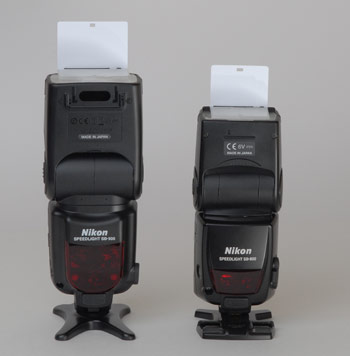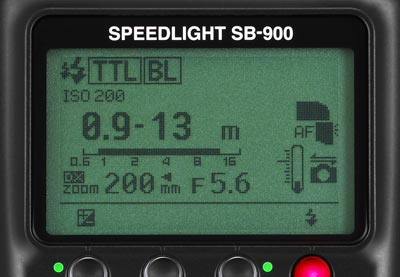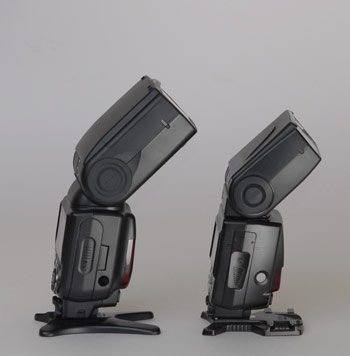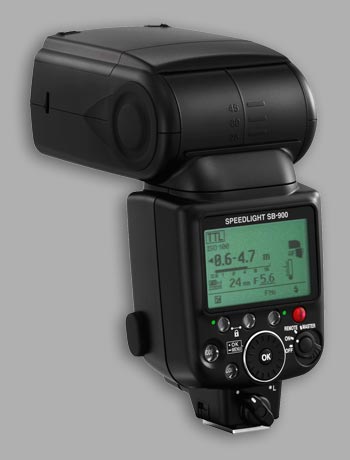|
 Big Stuff Big Stuff
7/27/08 (new)
the 900
A New Flagship In Port
Executive Summary:
SB-900: Bigger. Better. Larger. Smarter. Longer. Faster. Wider. More Adjustable. Taller. More Ergonomic. Thicker. Slightly Heavier. Spins Around Farther. Brawnier. Quicker to Set. Less Diminutive. Deeper. More Sizeable.
Did I mention it was a tad on the well-fed side of physical scale? There are good reasons. It contains more stuff. Stuff you will use all the time.
Remember the SB-800? It has been THE smartest, most flexible, most powerful, brightest, most talented external flash in all of hot shoe history. The top dawg in DSLR flash units, it has been the champion of champions in the Nikon CLS (Creative Lighting System) for years, along with its little brother, the SB-600.
 First appearing in 2003, the SB-800 first worked with only the D2H DSLR—later with most of the prosumer through pro models—and introduced the world to a new technology: beamed, encoded commands using Nikon's exclusive ADC (Advanced Data Communication) system, which allows CLS flash units to talk intimately with each other wirelessly, without radio control. First appearing in 2003, the SB-800 first worked with only the D2H DSLR—later with most of the prosumer through pro models—and introduced the world to a new technology: beamed, encoded commands using Nikon's exclusive ADC (Advanced Data Communication) system, which allows CLS flash units to talk intimately with each other wirelessly, without radio control.
Quick technology recap: Command mode flash units put out streams of super-quick coded micro flashes with timed intervals that coordinate other units, their status, settings, modes, channels, groups, behaviors, brightnesses and timings, all of which is read by the camera's exposure computer in flash TTL, Manual or locally Automatic modes.
In other words, the flash units are all working together more completely than any system previously (or since) imagined. Settings made at the camera can orchestrate any number of units over four channels and three groups, none of which are connected to each other, with all of them singing the same song in perfect harmony. Each of the three groups can be individually adjusted, mode changed and refined at the camera.
It's not just an interesting variation on flash unit tweaking, it's a feature so strong it must be balanced into any DSLR purchasing decision.
Now the top model in this rarified stratosphere of external flash units must give way to the new King of Late Night, the SB-900, introduced July 1, 2008.
 Put a mark on that calendar date. Send a Happy Birthday note to Nikon next year. Because if you get one of these for your D70, D80, D200, D300 or D700 right now, you're going to be a better flash photographer next summer, and you will know why. Even if you've already gathered lots of experience with the SB-800s and/or SB-600s. Put a mark on that calendar date. Send a Happy Birthday note to Nikon next year. Because if you get one of these for your D70, D80, D200, D300 or D700 right now, you're going to be a better flash photographer next summer, and you will know why. Even if you've already gathered lots of experience with the SB-800s and/or SB-600s.
The new SB-900 weighs a tad more than the SB-800, puts out about the same amount of flash power, nominally, and is notably physically larger than the SB-800. Many of the internal functions are familiar and carry the same terminologies, but there the comparisons end. Once you fool around with the SB-900 for an hour, you realize that this is a complete re-think about what an external camera flash needs to be.
Mounted on the Camera
It weighs 65 grams more than the SB-800 (2.3 ounces) at 415 g (14.6 oz) and connects directly with the camera through its six-contact (five pins plus ground) metal foot.
Attaching the 900 to our D300 showed an immediate first impression: Geez, that's a solid connection. The lock snaps into place with a solid thwack like it just could NOT wait for you to touch it.
Power comes from four AA batteries and recycle times are on a par with SB-800s, using that model's fifth add-on battery. The SB-800 requires this extra battery, and its compartment in order to meet recharge and output maximum specs, but the SB-900 gets almost identical performance from one less battery. Of course, you can always power either of them from various Nikon external power options.
The array of controls below the illuminated control screen include seven buttons, one rotating dial and a four position locking selector switch. By outfitting the unit with dedicated buttons and switch selections for specific functions, Nikon has simplified and made complex settings more intuitive.
The power switch's center button lets it easily switch On, but must be pressed to reach the Remote and Master click stops. These no longer require you to set them via menu modes, compared to previous models. The self-illuminated green screen shows you what the status of your settings are, and after a quick course in SB-900 linguistics, the many icons and numbers make greater sense.
Press the Mode button and the current flash mode highlights. Press it again and the next mode in the current logical series is selected. But you don't have to keep banging away at the Mode button to get to your desired selection. Spin the central Selector Dial and roll through all the possible settings on the monitor. Got one you like? Press the central OK button and you're good to go.
Like other CLS units, it works in M (manual), AA (auto aperture), A (on-board photocell-limited auto flash), GN (guide number computed exposures), TTL (through the lens computed exposure), FP (focal plane synchronized super high speed shutter), BL (balanced light for ambient light computed exposures), and RPT (repeating flash during exposures at true stroboscopic rates of up to 100 pulses per second).
And all of these are modes that are available with the flash mounted on the camera.
As a Master or Remote unit, completely different menu screens appear, and those modes work just like they do in the SB-800.
Niceties
 The SB-900 follows your zoom lens from 17mm to 200mm on an FX, full frame camera (D3 or D700) or a DX camera (D70 through D300), automatically switching correctly when mounted. Options in the menu system let you control this manually if you wish. The SB-900 follows your zoom lens from 17mm to 200mm on an FX, full frame camera (D3 or D700) or a DX camera (D70 through D300), automatically switching correctly when mounted. Options in the menu system let you control this manually if you wish.
Roll over the image to see the tiny FX indicator replace the DX one. Some animation, huh?
A flip out wide-angle diffuser covers the flash tube easily, stowing in the flash head, and like the SB-800, a catch-light reflector is in there, too, letting you do ceiling bounce plus eye-enhancing glints at the same time. With the wide angle diffuser, coverage is expanded to 8mm, 10mm or 11mm DX lens spreads, or 12, 14 or 17mm FX spreads.
In other words, you're covered in wide blasts no matter what optic you choose, even into the ultra-wide coverage of the 10.5mm fisheye (when straightened in Capture NX). Shooting with the fish and the SB-900 is an exercise in Wholey Cow. There's a little vignetting in the very corners of the original curved image, and all of that goes away completely when you flatten the image with iNovaFX Photoshop Actions or Capture NX's fisheye straightener.
The head spins 180 degrees in both directions, so you can set the direction and angle anywhere in the hemisphere away from the hot shoe.
Like the SB-800, the flash head can be pointed down 7.5 degrees for better close-up coverage. When you do this, the LCD shows an arrow in the flash head icon, indicating the change, and although it doesn't sound like much of a difference, the light now converges with the lens path at less than two meters out front. If you do this, here's a tip: Use the wide diffuser. It softens the light source a bit and lowers the photon count on nearby subjects.

Data display LCD is brighter than the one on the SB-800.
Want to dial in an overall flash brightness correction? The four topmost buttons can be identified with icons appearing nearby on the LCD data display. Like the SB-800 LCD, the entire display is made of tiny square pixels, so any graphic can be generated at any spot. So look for the familar +/- icon, press the nearby button and instantly, you're fixing the exposure by 1/3-stop increments.
Indicators on the LCD keep you informed about flash modes, EV compensations, system health (that thermometer icon shows how hot the flash tube has gotten so you can adjust your shooting pace before overheating and being forced to take a little temperature break), status of flash-to-camera communication, camera settings like ISO and aperture, and even a bar chart that shows you how far and near the flash can work with current camera conditions.
Big numbers spell this out for you (e.g. "3.0 - 66 > ft") above the bar but after a while your eyes just look for the graph. For whatever reason, the highest far distance number maxxes out at "66" feet, but a little triangle suggests that more distance is available.
In night tests at ISO 6400, we punched through the clear mountain air around here well over 200 feet away.
The flash head zooms in sync with your Nikor zoom lens. Interestingly, it gets its zooming orders directly from the lens, not the camera's computer which is aware of image format more completely. With the Nikkor 28-200mm lens—designed for full frame film cameras, originally—on the D300, it assumed coverage for FX, full frame, format.
Flash coverage can become Standard, Center Weighted or Even. Settings are made in the menu system.
- Center weighted tunnels the light a bit, which gently covers subjects floating in a sea of distant background. Moreover, by concentrating light centrally, long hallway-like environments are better exposed.
- Even lighting is flat, flat, flat. No vignetting here.
- Standard is an efficient compromise, rather like that of most of the world's flash units.
SU-4 remote flash mode turns it into a simple slave unit or a much more complex repeat slave unit in several interesting ways. One of which has the SB-900 firing its xenon tube in perfect sync with the initiating flashes—when the master starts to fire, the SB-900 fires, and when the master extinguishes its plasma flame, the SB-900 quenches its flame, too. Or, you can have the remote SB-900 fire off standard strength blasts on the rise time of the master unit.
With these settings, you can have the SB-900 behave proportionally bright with a manual single-pulse camera flash. If you change the camera's manual setting, the slave SB-900 will change its pulse duration in sync, thus controlling brightness of both sources synchronously.
 Color light-matching filters are included. They mount in the provide Color Filter Holder that snaps over the face of the flash port. Four of them tweak the flash output to match two fluorescent options, daylight and incandescent. Color light-matching filters are included. They mount in the provide Color Filter Holder that snaps over the face of the flash port. Four of them tweak the flash output to match two fluorescent options, daylight and incandescent.
Did I mention that the SB-900 has a
substantionally larger flash head?
The tweak filter that matches flash to daylight is such a faint warm shade that we suspect its presence will be only noticed if you tell the viewing audience it was used. The most useful filter is the amber correction A1 filter that turns the SB-900 into an incandescent flash light source. Set the D300 to Incandescent and blaze away.
SB-900s come with a custom padded case, the SS-900. Every accessory except the instruction manual fits in it. Four compartments hold flash, covers, filters and tripod base/stand.
Commander and commanded remote modes are present in the SB-900 just as they are in the SB-800. As master and commander, it includes one more channel for remote units, compared to the in-camera Commander modes.
In fact, you can mount the SB-900 on a D40, D40x or D60 and turn that camera into a full-fledged Command Mode master controller for extensive flash setups.
With the D300, the SB-900 is a better match than the SB-800. Five years ago, when the SB-800 first appeared, the emphasis was on features, power and technology. Today, the SB-900 demonstrates one of those "how far have we come" evolutionary turns. It has about 1/10th of a stop less power, but is miles ahead of the SB-800 in sheer ergonomics, zoom range, adaptability to complex setups and camera-enhancing flash situations.
Negatoids:
There are a few. Did I mention that the SB-900 is a little bit porky? In volume it is about 10% bigger in all directions than the SB-800. Making it roughly 33% more massive. But it weighs just 18% more because nearly all of that extra volume is in the flash head, caused by its larger zoom range.
The included AS-21 tripod stand is simpler and cheaper than the AS-19 packed with the SB-800, and has no metal tripod attachment socket. Threads are plastic, and I'll probably rarely use it, since the other is available to me.
W e think there is further opportunity to refine the locking foot. This one is fine, mind, but we feel that an automatically locking foot is not only possible and desirable, but doable. e think there is further opportunity to refine the locking foot. This one is fine, mind, but we feel that an automatically locking foot is not only possible and desirable, but doable.
Purchasing Realities:
People will wonder: Is the SB-900 worth the $150 premium over an SB-800, and after playing with it and getting experimental results back so soon, so well and so delightfully, we have to say "oh, yes."
Just to be clear; if you shoot with a Nikon DSLR and you don't already have an external flash unit but have aspirations to move into a good flash system, get the SB-900. It will cost you something just south of $500US, and you can get SB-800s for under $350US, but the ergonomics, zoom range, special features, power, speed of operation and speed of quickly understanding the 900 are worth the extra bucks.
If you are looking for a second flash unit and already have something like the SB-800/600s in hand, you probably want at least one SB-900 for all its extra talents when used on the camera.
If you already have an SB-900, you might just as well get SB-800s from here on, since those work dazzlingly well as remote units commanded by the camera or the SB-900 mounted on the camera. Wedding photographers (think portable, fast-working, need control now, not five minutes from now) buy them by the six-pack. Some will obtain SB-900s by the cluster, too.
Nikon CLS flash units are the best of all small flash units. The thing that makes them so desirable is their depth of features, build quality and especially their Command Mode operation which is so good, it will keep you from investing in a Canon DSLR, if flash is important to you.
[I own Canon DSLRs (3) and their previous front-runner flash model. Their gear is good, but not in this league. The last time I used it was over 18 months ago. I use the Nikon system all the time.]
The SB-900 appears to have taken the top spot in the Nikon flash unit line by a landslide.
Meaning, another five-star, super duper flash unit from Nikon. They seem to have been collecting an inordinate amount of "Duper" these days, but what can we say? They've earned it.

(so far, so good)
—Peter iNova
Return to Breaking News
|

